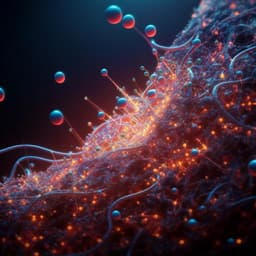
Chemistry
Discovery of *Trypanosoma brucei* inhibitors enabled by a unified synthesis of diverse sulfonyl fluorides
B. S. Mantilla, J. S. White, et al.
Discover the groundbreaking research conducted by Brian S. Mantilla and colleagues at the University of Leeds and the University of St Andrews, who developed a unified synthesis of sulfonyl fluorides. Their innovative photoredox-catalyzed approach led to the identification of compounds with remarkable anti-trypanosomal activity, revealing new therapeutic potential against *Trypanosoma brucei*.
~3 min • Beginner • English
Introduction
Electrophilic bioactive compounds, particularly those equipped with bioorthogonal tags, are powerful chemical tools for probing biological mechanisms and drug–target engagement in cells. Recent successes include FDA-approved covalent drugs across oncology and virology. However, structural and functional diversity in electrophilic probe libraries is constrained by limited building blocks and a narrow set of robust reaction classes, often focusing on warheads that target catalytic cysteines. Sulfur(VI) exchange chemistries have expanded access to alternative warheads, and simple sulfonyl fluoride fragments predominantly target lysine and tyrosine, with tailored probes also addressing histidine, serine, threonine, and cysteine. The present study asks whether a unified, connective, photoredox-mediated dehydrogenative coupling strategy can rapidly generate skeletally and functionally diverse sulfonyl fluoride probes from readily available hetaryl sulfonyl fluorides and saturated heterocycle hydrogen donors, and whether such a library can yield novel inhibitors of Trypanosoma brucei. The approach also aims to streamline target deconvolution by designing hits amenable to alkyne installation for chemical proteomics.
Literature Review
The authors highlight constraints in chemical space explored by electrophilic probe sets due to reliance on a small toolbox of reactions, yielding limited scaffold and reactivity diversity. Established electrophilic screening collections (e.g., α-halo, Michael acceptors) largely target reactive cysteines. S(VI) exchange chemistry has been developed to produce diverse fragments with complementary warheads, and proteome-wide studies show sulfonyl fluorides often modify lysine and tyrosine but can be tuned to other residues. Prior work demonstrates the value of electrophilic probes and activity-based protein profiling for target discovery, including sulfonyl fluoride tools and fluorophosphonate probes for serine hydrolases. Within kinetoplastid biology, T. brucei contains enzymes known to be susceptible to sulfonyl fluorides (e.g., phenylmethylsulfonyl fluoride and diisopropylfluorophosphate inhibiting GPI pathway enzymes), motivating exploration of sulfonyl fluoride-based probes against these parasites.
Methodology
Unified synthesis: Photoredox-catalysed dehydrogenative coupling was used to connect hetaryl sulfonyl fluorides (HA A–F; benzothiazole, pyridine, quinoline, isoquinoline, pyrazole derivatives) with hydrogen donors (HD 1–20; diverse saturated N/O heterocycles including N-alkoxycarbonyl and N-acyl secondary amines, cyclic ethers, N-methyl lactams, a urea). Standard reaction conditions per screen: to a 1 mL acetone solution were added hetaryl sulfonyl fluoride (200 µL of 1.5 M), hydrogen donor (5 eq; typically 333 µL of 1.5 M; for HD 6, 9, 10 used 30 eq), TFA (100 µL of 2 M), Ir[dF(CF3)ppy]2(dtbbpy)PF6 (1 mol%; 100 µL of 0.01 M), and tert-butyl peracetate (159 µL, 50% w/v), topped with acetone (107 µL). Reactions were irradiated at 390 nm (Kessil lamp) in a fan-cooled HepatoChem lightbox with stirring for 24 h. Crudes were analysed by LC-MS, 1H/19F NMR; promising reactions were purified by mass-directed HPLC (gradient 5:95→95:5 acetonitrile:water) and lyophilized.
Substrate pairing strategy: Initial couplings tested HA A–F with N-Boc pyrrolidine (HD 1), identifying productive pairs (A-1, C-1; and D promising). Subsequently, HA A was paired with HD 1–20, prioritizing productive donors (HD 1, 3, 4, 16, 17; HD 2, 13, 14; HD 6, 10; HD 8, 12; HD 20). These donors were then combined with HA C and HA D to expand the library. Positional selectivity was noted: HA C initially substituted at C-6 (followed by 2- or 4-positions for di-substitution); HA D at position 1 (with one 1,3-disubstituted case). In total, 32 sulfonyl fluoride probes were prepared.
Antiparasitic screening: T. brucei brucei bloodstream forms (strain 427, single marker) were assayed in 96-well format across 0.1–100 µM (0.5% DMSO). Parasites were maintained in HMI-11 with 10% FCS and G418 (2.5 mg/L) at 37 °C/5% CO2; seeded at 5×10^5 cells/mL; incubated with compounds 66 h. Resazurin (1.1 mg/mL; 10 µL) was added for 6 h; fluorescence (Ex/Em 560/590 nm). EC50s computed by sigmoidal dose-response fits; initial n=1 screen; hits re-screened with n=4 technical replicates. Selectivity assessed in HeLa resazurin assay under standard DMEM conditions (10% FBS, L-glutamine, pen/strep), 66 h incubation, 72 h total with resazurin, n=4 technical replicates; EC50 via LL.4 log fit in R.
Chemical proteomics with an alkynylated probe: An alkynylated analogue of C-1 (C-1alk) was synthesized by deprotection followed by propargyl chloroformate installation. Activity against T. brucei was measured (EC50 determination as above). For target profiling, parasite lysates (~25 µg per reaction for in-gel; 1 mg/mL for pulldown) were incubated with C-1alk (typically 1.5 µM, 1 h, 25 °C, 600 rpm). Click chemistry (CuAAC) used rhodamine-azide (100 µM) or biotin-azide (100 µM) with CuSO4 (50 µM), TCEP (100 µM), TBTA ligand (50 µM) in presence of 1% SDS, followed by quench with 20 mM EDTA and protein precipitation. In-gel fluorescence imaging was performed post-SDS-PAGE; total protein assessed by Coomassie. For biotin pulldown, precipitated proteins were resuspended, diluted to 0.2% SDS-PBS, captured on NeutrAvidin agarose (2 h), washed (0.2% SDS-PBS, 8 M urea, PBS, 50 mM TEAB), reduced (12.5 mM TCEP), alkylated (18.75 mM iodoacetamide), and digested on-bead with trypsin (16 h, 37 °C). Peptides were desalted (tC18) and analysed by LC-TIMS-MS/MS (Bruker timsTOF Pro 2, nanoElute 2; Aurora Elite C18, 30 min gradient 2–35% B; PASEF DDA with 10 scans, 1.16 s cycle; data processed in MaxQuant/Perseus with FDR 1% and LFQ; open search for modified peptides via MSFragger/PTM-Shepherd; statistical testing by modified t-test with permutation-based FDR 0.01, s0=0.2). Competition experiments pre-incubated lysates with C-1 at 50 nM, 0.5 µM, 2.5 µM prior to C-1alk.
Fluorophosphonate (FP) serine hydrolase profiling: Lysates were incubated with sulfonyl fluoride probes (100 µM; including C-1, A-3a, D-3a, D-10b), then treated with FP-Rh (2 µM) for in-gel visualization and competition by C-1; quantitative competition assessed by densitometry of predominant ~25–27 kDa band across C-1 concentrations (EC50 from fit). FP-biotin (4 µM) pulldowns profiled serine hydrolases; competition with 1 µM C-1 assessed proteins depleted relative to FP-biotin alone.
Key Findings
- Library synthesis: 32 sulfonyl fluoride probes were prepared via a one-step photoredox dehydrogenative coupling, spanning 23 distinct graph-node-bond frameworks and exhibiting positional selectivity on hetarenes (HA C and HA D).
- Antiparasitic activity: In T. brucei bloodstream-form assays, 10 probes had EC50 < 10 µM; 4 had EC50 < 1 µM. Representative potencies and selectivity indices (SI, HeLa): A-3a EC50 0.50 ± 0.01 µM (SI 37); D-3a 0.62 ± 0.01 µM (SI 66); D-10b 0.62 ± 0.01 µM (SI 42); D-19a 0.31 ± 0.01 µM (SI 41); A-3b 2.82 ± 0.06 µM (SI 26); C-4 3.84 ± 0.04 µM (SI 22); D-10a 4.68 ± 0.04 µM (SI 24); C-3 6.36 ± 0.07 µM (SI 16); D-13 7.18 ± 0.05 µM (SI 12). The 10 most active probes showed 12–66-fold selectivity for T. brucei over HeLa. Activities were 17–500-fold higher than the parental hetaryl sulfonyl fluorides HA A (EC50 111 ± 3 µM), HA C (154 ± 2 µM), and HA D (124 ± 3 µM), underscoring the importance of substitution patterns.
- Warhead contribution: For A-3a, the α-cyano amine, not the sulfonyl fluoride, was critical for activity (A-3a EC50 0.50 µM; analogue lacking sulfonyl fluoride EC50 1.37 µM; A-1 lacking α-cyano EC50 101 ± 2 µM), so A-3a analogues were deprioritized for proteomics.
- Alkynylated probe: C-1 exhibited EC50 0.31 ± 0.01 µM; its alkynylated analogue C-1alk retained activity (EC50 3.28 ± 0.03 µM) and robustly labelled many proteins in lysates.
- Proteome enrichment: C-1alk significantly enriched 95 proteins versus DMSO, with GO over-representation in nucleotide binding, translation machinery, and hydrolases. A modified peptide consistent with sulfonyl fluoride modification was identified for glycerol kinase (Q38DF0) at S137/T138/Y139; Y139 is highly conserved and proximal to the substrate site.
- Competition by parent ligand: Pre-incubation with C-1 (50 nM–2.5 µM) prior to C-1alk labelling significantly depleted two proteins: D6XM23 (putative lysophospholipase) and Q57X73 (putative nucleoside hydrolase). D6XM23 intensity decreased with increasing C-1 and was undetectable at 2.5 µM; Q57X73 was absent upon any C-1 pre-treatment.
- Serine hydrolase targeting: FP-Rh in-gel profiling showed multiple bands competed by C-1 and other sulfonyl fluoride probes; a prominent ~25–27 kDa FP-Rh band was outcompeted by C-1 with EC50 46.4 ± 5.5 nM. FP-biotin pulldowns after C-1 treatment significantly depleted 15 proteins including lyso-phospholipase (D6XM23), glycerol kinase (Q38DF3), and prolyl oligopeptidase S9 (Q38AG2), consistent with serine hydrolase engagement.
- Collectively, the data indicate C-1 modifies multiple targets, including enzymes in purine salvage, lipid metabolism, and glycolysis, with several localised to glycosomes.
Discussion
The study demonstrates that a photoredox-mediated, connective synthesis can directly furnish structurally diverse sulfonyl fluoride probes from simple building blocks while preserving sulfonyl fluoride functionality. This expands scaffold diversity beyond what is accessible via S(VI) exchange methodologies and complements cysteine-targeted warheads by emphasizing lysine/tyrosine and potentially serine engagement. Functionally, the library displayed >300-fold variation in antiparasitic activity, validating the approach for hit discovery against T. brucei. Designing compounds to allow facile alkyne installation enabled rapid target deconvolution. Proteomics with C-1alk revealed extensive proteome engagement but competition experiments with the parent C-1 narrowed likely primary targets to a subset, notably a putative lysophospholipase (serine hydrolase) and a nucleoside hydrolase. FP-based profiling corroborated engagement of serine hydrolases. However, genetic data suggest that at least lyso-phospholipase is non-essential for proliferation or virulence, and nucleoside hydrolase essentiality is context-dependent, implying that C-1’s antiparasitic effect likely arises from multi-target covalent inhibition. Several enriched targets, including glycerol kinase and glycolytic enzymes, are glycosomal, suggesting that perturbation of glycosomal metabolism may underlie the potency and selectivity observed. Overall, the findings address the original hypothesis by showing the unified synthesis yields both structural and functional diversity and can discover active, mechanistically tractable probes.
Conclusion
A unified photoredox dehydrogenative coupling strategy enabled rapid preparation of 32 skeletally diverse sulfonyl fluoride probes, several with sub-micromolar activity against T. brucei and favorable selectivity. Strategic incorporation of an alkyne (C-1alk) facilitated chemical proteomics, which, together with FP-probe profiling, indicates multi-target engagement, including serine hydrolases and enzymes in purine and lipid metabolism, potentially within glycosomes. The work provides a general route to structurally diverse electrophilic probes and demonstrates their utility in phenotypic screening and target deconvolution. Future directions include scaling the diversity-oriented synthesis to larger libraries, refining warhead and scaffold combinations for increased selectivity, validating candidate targets in cells (e.g., by genetics/chemistry), and exploiting organelle-specific targeting to enhance antiparasitic efficacy.
Limitations
- Library size was modest (32 probes), limiting chemotype coverage and the likelihood of highly selective target engagement.
- Chemical proteomics indicated broad proteome labelling; competition narrowed candidates but definitive primary targets were not unambiguously validated functionally.
- Sulfonyl fluoride modifications on residues such as serine can be labile and may be under-detected in standard proteomic workflows; despite protocol adjustments (e.g., avoiding thiol reducing agents), some targets may have been missed.
- Genetic data suggest key competed targets like lyso-phospholipase and nucleoside hydrolase are not strictly essential alone, supporting a multi-target mechanism that complicates interpretation and validation.
- Discrepancies between lysate-based target engagement and cellular context may exist; on-target effects in live parasites were not directly confirmed for specific proteins.
Related Publications
Explore these studies to deepen your understanding of the subject.







